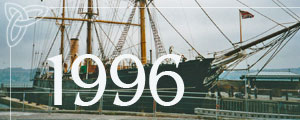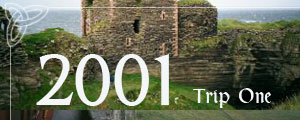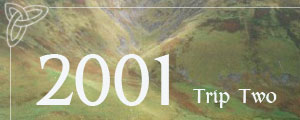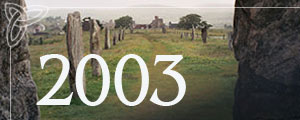2001 Tour - Part One
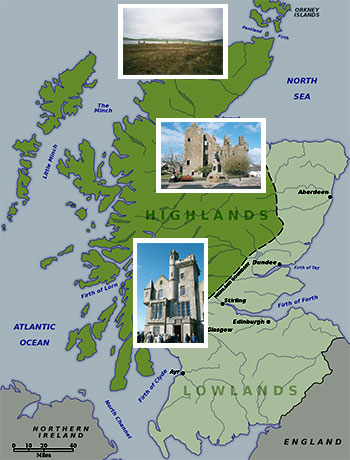
Ballachulish
Loch Leven
Glen Coe
Inverness
Loch Ness
Culloden
Wick
Orkney Islands
Shapinsay
More Orkney
Banchory
Drum Castle
Edinburgh
Accompanying text, written by Alice Jean Matuszak, as it appeared in The Holly Leaf.
Start
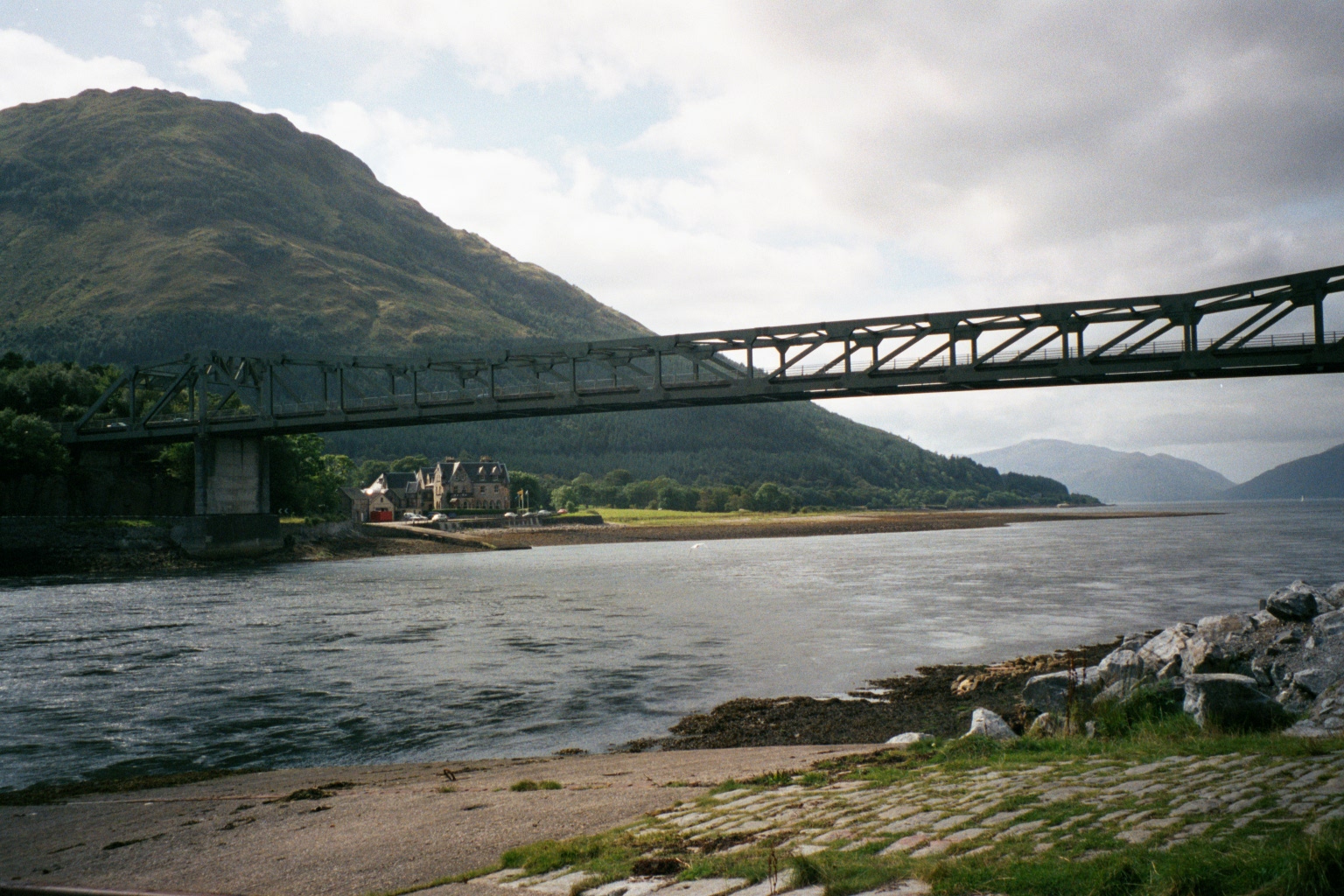
The Ballachulish Bridge
Ballachulish
September 4, 2001
The Clan Irwin tour group met at the Glasgow airport, boarded our bus and proceeded north across the River Clyde on the Erskine Bridge to the Great Western Road travelling along the western shore of Loch Lomond, past Ben Lomond, through Glen Fallock and Glen Coe to Ballachulish and the Isles of Glencoe Hotel on the shores of Loch Leven, our home in the Highlands for 3 nights. Conspicuous along the roads were rowan trees with beautiful red berries. Known as mountain ash in America, the rowan trees are said to have been planted "to deter witches."
Loch Leven
September 5, 2001
We took the Nevis Range Gondola on Aonach Mor to the gondola top station for spectacular views of Ben Nevis, at 4406 ft. the highest mountain in the UK, the Nevis range and Fort William. A downhill mountain-biking track parallels the gondola sky route in this ski resort.
We had lunch at North Ballachulish at the Loch Leven Inn with views of their gardens under the bridge; especially spectacular were blue-purple hydrangeas and orange lilies. We saw Scottish "tablet", a kind of fudge and chocolate truffles being made at the Great Glen Confectionary Factory; these sweets are sold all over Scotland. We had our first taste of Orkney ice cream which was well worth remembering also.
We spent the afternoon in a circular drive around Loch Leven and a visit to the Glen Coe National Trust visitor center for a slide presentation about the 1692 massacre of the MacDonalds by King William's soldiers, who had been guests of the MacDonalds for the preceeding 12 days. The scenery around Glencoe is spectacular, truly the heart of the Highlands.
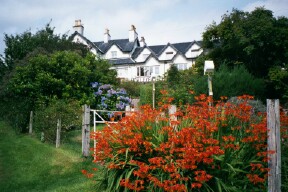
Loch Leven Inn
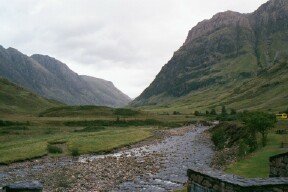
Glen Coe
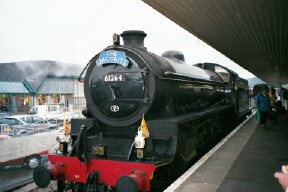
The Jacobite steam train
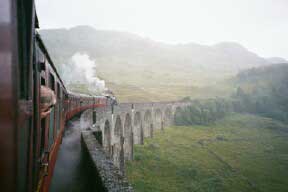
Glenfinnan Viaduct from the train
Glen Coe
September 6, 2001
We spent most of the day taking a wonderful round-trip train ride from Fort William to Mallaig on "The Jacobite" steam train operated by the West Coast Railway Co. The route follows the famous "Road to the Isles." Especially interesting is the 21-arch Glenfinnan Viaduct with views over Loch Shiel and the Jacobite monument where Bonnie Prince Charles raised his standard in 1745 in an attempt to regain the Throne of Great Britain for his father James Edward, "King over the Water."
We learned that this section of the railroad will appear in the second Harry Potter film due out in 2002; we also caught a glimpse of a train on a siding near Fort William that we were told was the "Hogworts Express."
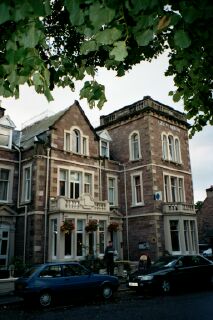
Inverness Hotel
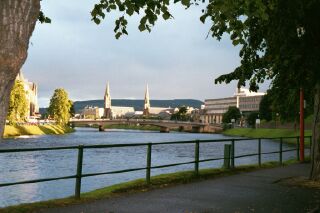
Inverness
Inverness
September 7, 2001
We travelled by bus from our hotel to Fort William to Inverness, travelling through the Great Glen with stops at Fort Augustus with its "topiary Nessie" and at Drumnadrochit to visit the Loch Ness Center's exhibit on the science and myths of Loch Ness.
In Inverness we stayed for two nights at the Glen Mohr Hotel that is across the street from the River Ness and about two blocks from the shopping heart of the city.
“My heart's in the Highlands, my heart is not here;
My heart's in the Highlands a-chasing the deer;
A-chasing the wild-deer, and following the roe,
My heart's in the Highlands wherever I go.”
― Robert Burns
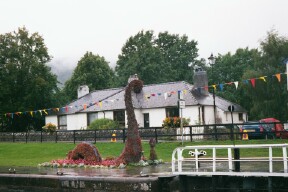
Loch Ness Topiary
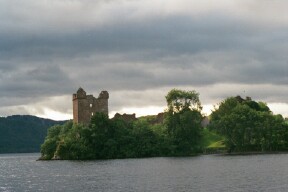
Urquhart Castle
Loch Ness
September 8, 2001
The Clan was joined by Ian MacKenzie, Retired Pipe Major for the Queen's Own Highlanders, and his friend Catherine, who served as guides for our day around Inverness. Ian piped the Clan aboard "The Jacobite" for a round-trip cruise on Loch Ness to Urquhart Castle. The scenery was spectacular but there were no sightings of Nessie, the Loch Ness monster.
The Clan then split into two groups with one group going with Ian and Catherine to tour Castle Stuart, restorted former home of the Earl of Moray. The other group visited Cawdor Castle, its beautiful gardens and farm which were complete with a lovely orange marmalade cat and some Highland coos.
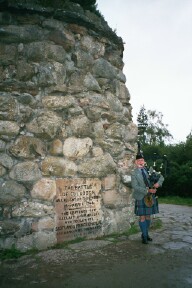
Culloden Moor Battlefield Memorial Cairn
Culloden
September 8, 2001
The whole clan toured the Culloden Moor battlefield with Ian as our guide. With all the clan standing (in the rain) Ian slowly circled the Memorial Cairn piping a beautiful lament for the 1200 Highlanders who fell during the battle of 16 April 1746, When Prince Charles Edward Stuart, Bonnie Prince Charlie, and his army were defeated by the Duke of Cumberland and his army. Also lamented was the loss of identity (destruction of the clan system, banning the tartan dress, banning the bagpipes as an instrument of war) and the change of lifestyle that lead to the Highland clearances.
The evening concluded in a happier mood when Ian piped the Clan into dinner at the hotel. Ian and Catherine truly made our day unforgettable and our visit to Culloden especially meaningful.
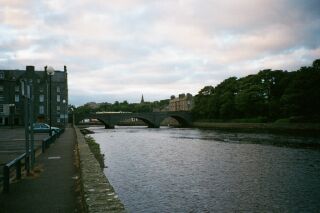
River Wick
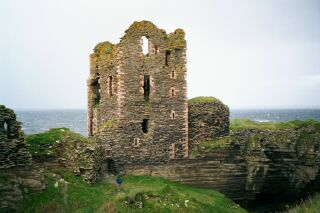
Sinclair Castle
Wick
September 9, 2001
The Clan boarded the bus for the trip north. We passed Cromarty Firth where we could see North Sea oil rigs being repaired, past Dornoch Firth and Skibo Castle with connections to Madonna's recent wedding, past Dunrobin Castle to Wick and one night's stay at the Norseman Hotel near the Wick River. We toured the Caithness Glass Factory and filled our luggage with those beautiful glass paperweights.
Part of our group decided to visit the ruins of Sinclair (17th century) and Girnigoe (15th century) Castles and view the lighthouse of Noss Head. An absolute downpour put an end to this excursion which necessitated climbing fences and traversing several fields with very muddy paths.
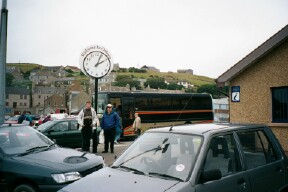
Stromness
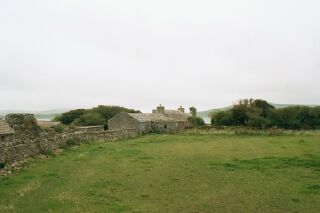
Kirbuster Farm
Orkney Islands
September 10, 2001
The Clan headed north from Wick to John O'Groats, one of the most northern points on mainland Scotland, and one from which we could see the Orkney Islands across the Pentland Firth. Many photos were taken of the "last house in Scotland." We then traveled west through Thurso to Scrabster on Thurso Bay.
The Clan was met by our kinsman James Irvine of Surrey, England, whose Irvine ancestors had lived in the Orkneys. James with his knowledge of history and genealogy served as our guide, mentor and friend during our 5-day visit to the Orkneys. The Clan plus our bus took the 2-hour ride on the P&O Ferry "St. Ola" from Scrabster past the island of Hoy with its "Old Man of Hoy," a 400 ft. rock stack, to Stromness on Mainland Orkney. The Clan took lunch on the ferry with some of the party getting their first taste of that wonderful Orkney ice cream.
We toured the Ring of Brodgar, a stone circle originally containing 60 megaliths and now with 36 remaining upright. It is part of The Heart of Neolithic Orkney World Heritage Site. After checking into the Kirkwall Hotel on Harbour St., our home for four nights, we walked through Kirkwall to St. Magnus Cathedral, built by Magnus' nephew Rognvald Kolson and consecrated about 1150. This beautiful old red sandstone cathedral belongs to the people of Kirkwall and Orkney. The Clan toured the cathedral with assistant Curator Ingrid Jollie and James Irvine who pointed our several Irving tombstones and a stained glass window bearing the Irving holly leaf.
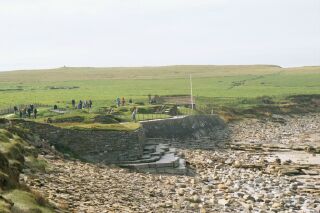
Skara Brae
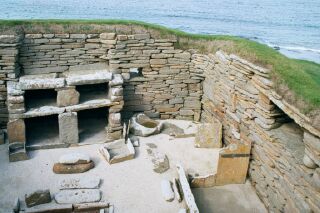
Skara Brae Site
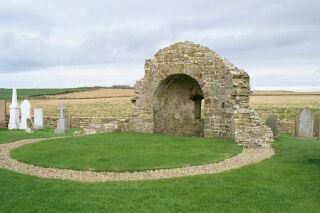
Orphir Church
Orkney Islands
September 11, 2001
Sheena Wenham served as our guide for a tour of the West Mainland historic sites. We began with the Broch of Gurness, a late Iron Age settlement-Last Century BC/First Century AD-occupied for hundreds of years. We traveled past the Brough of Birsay with remains of early Christian and Norse settlements to Birsay where we viewed ruins of the 16th Century Earl's Palace, built by Robert Stewart, half-brother of Mary, Queen of Scots, and St. Magnus Church, Birsay.
This Church, built on the site of the original Christchurch, was built about 1064 and is believed to be the original burial site of Magnus Erlendson, whose bones are believed to rest now in St. Magnus Cathedral in Kirkwall.
We next toured the Kirbuster Farm Museum composed of several buildings and rooms that depicted various time periods. Especially interesting was the 'fire hoose' that had no chimney but had an open fire with a 'fireback,' smokehole in the roof, beds built into the stone wall, a 'neuk-bed,' and codfish hanging from straw ropes and being smoked over the fire.
Overlooking the Bay of Skaill, this housing colony was buried for 4500 years until a wild storm in 1850 stripped off the grass and sand to uncover the midden heap and the dwelling structures. It was both beautiful and awesome.
Nothing could be in sharper contrast to Skara Brae than the next building we visited, 17th Century Skaill House considered 'the finest mansion in Orkney' and standing about 200 yards from Skara Brae. The Clan was very fortunate to tour Skaill House with the 12th Laird, Major Malcolm Macrae and with James Irvine, who wrote the 'official' guide book to Skaill House.
The Clan then split into two groups with one group going with James Irvine on a two-mile cliff-top walk viewing Irvine/Irving country, Yescanabie castle, etc. The rest of the Clan visited Orphir to see an audiovisual presentation of the Orkneyinga Saga and to view Orphir Church, ruins of Scotland's only Medieval Church which was constructed in the first part of the 1100s and dedicated to St. Nicholas.
As they returned to the bus from these expeditions, Clan members learned of the 9-11 tragedy in the USA. (Scotland is 5 hours ahead of the Eastern Time Zone.) The day ended with a return to the Kirkwall Hotel and everyone watching developments on BBC television and attempting to contact family and friends in the USA.
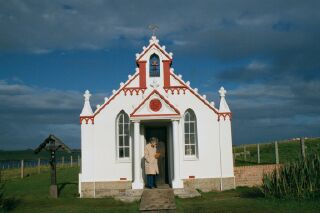
Italian Chapel
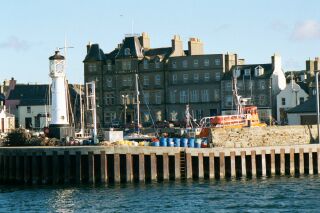
Kirkwall
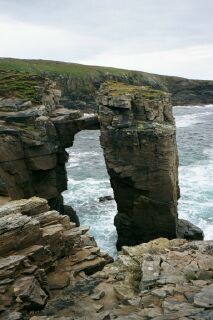
Yesnaby Castle
Orkney Islands
September 12, 2001
The morning was free in Kirkwall. Most Clan members revisited St. Magnus Cathedral and/or toured the Mid-12th Century Bishop's Palace, the 17th Century Earl's Palace and the Orkney Museum in Tankerness House, whose exhibits included mounted puffins, bog butter, tartan that had been buried in a bog, rocks with Pict carvings, rune stones along with pre-historical and historical artifacts excavated from various archeological sites.
After lunch the Clan boarded the bus to go to the Highland Park Distillery. We were greeted by the Highland Park cats, an orange-marmalade named Barley and a grey-brown tiger named Malt. The Distillery tour included all aspects of producing single malt scotch whisky and the opportunity to taste a wee dram. We then visited the Italian Chapel which was built during WWII by Italian POWs. Orkney is known for arts and crafts based on its historic sites and beautiful scenery.
The Clan had the opportunity to make two of the stops on the 'Orkney Craft Trail.' We visited the Sheila Fleet Jewellery Workshop in Tankerness to see her Orkney-inspired jewellery being made. We also toured 'The Workshop' in St. Margaret's Hope, a craft producers' co-op specializing in high quality knitwear and crafts. The evening was spent in St. Margaret's Hope visiting The Smiddy (Blacksmith) Museum, walking around the town and observing at least seven cats and enjoying dinner at the Creel Restaurant.
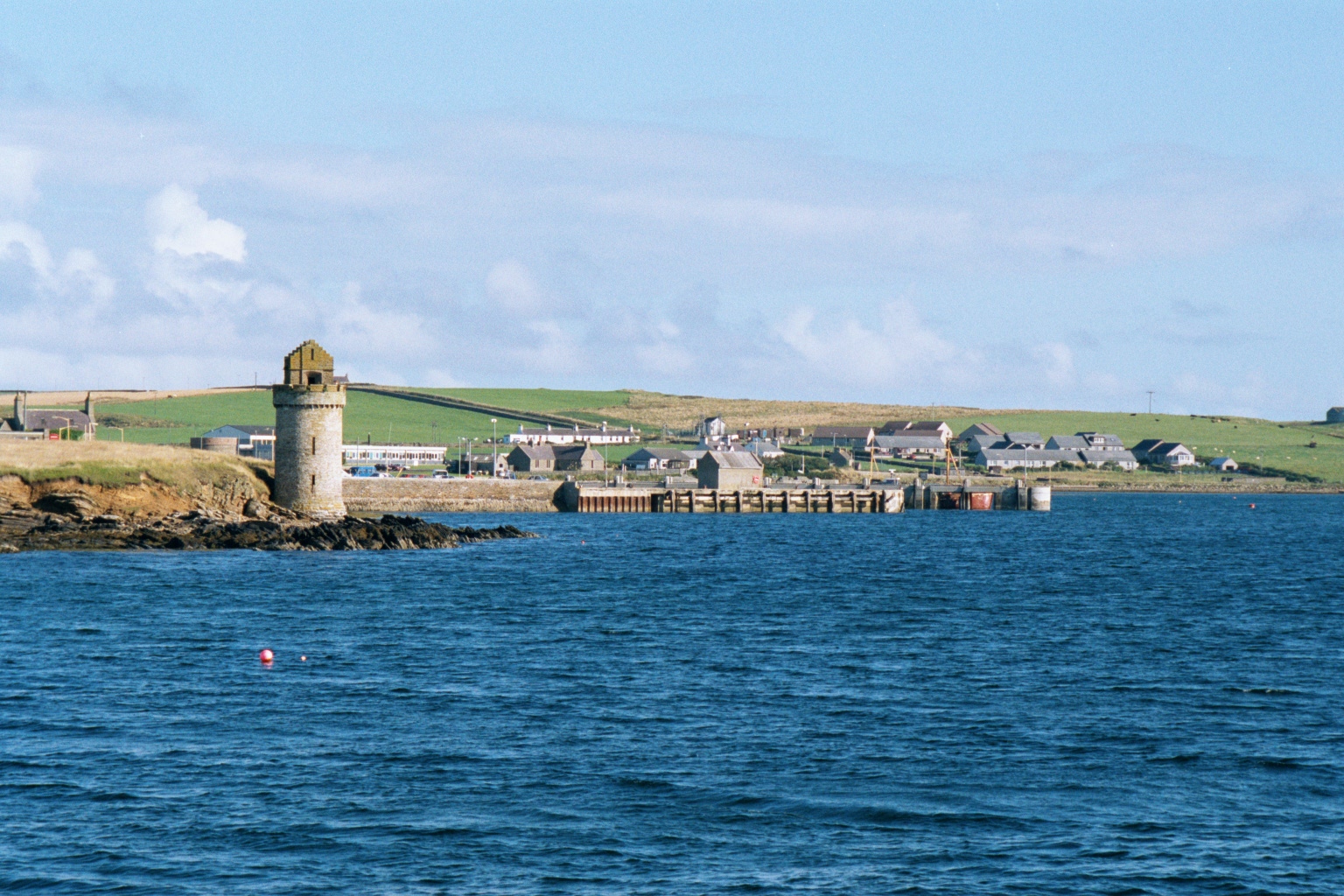
Shapinsay Island
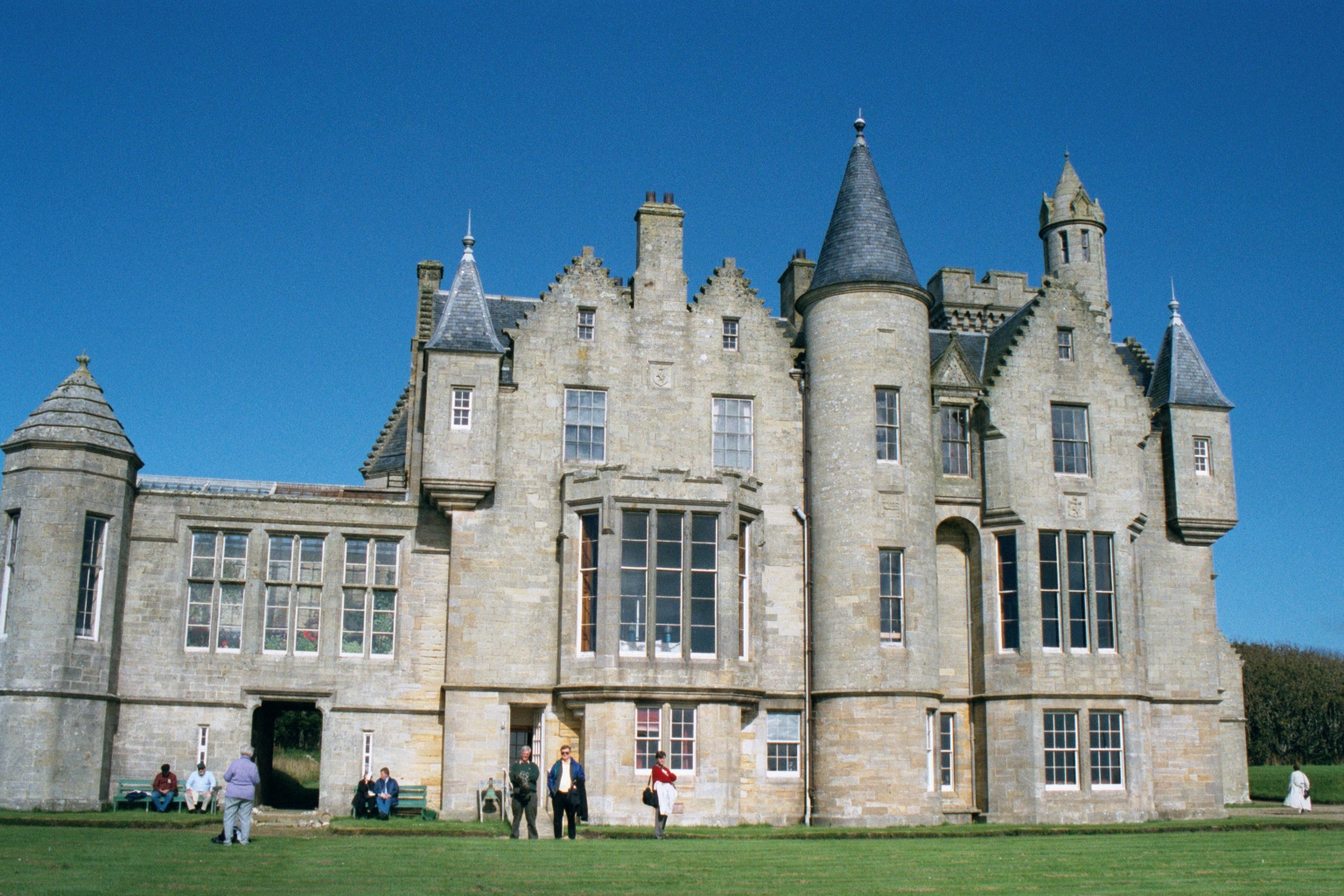
Balfour Castle
Shapinsay
September 13, 2001
The Clan plus our bus took the Orkney Ferry to Shapinsay Island. We were met by Patricia Zawadski who gave us a tour of the grounds and walled gardens of Balfour Castle. Patricia was assisted by an orange and white village cat. We were then met by Patricia's mother Katherine Zawadski, who has been Laird of Balfour Castle for the last 50 years. We had a tour of the Castle, refreshments in the beautiful conservatory and lunch in the elegant dining room.
Balfour Castle is a Baronial style Victorian castle completed in 1848 by Laird David Balfour. We learned that Robert Louis Stevenson was a friend of David Balfour and had visited the Castle. Stevenson used his friend's name for the name of his hero in the book Kidnapped.
The especially scary scene in the book where David climbs up the ruined staircase to the tower in the dark and stormy night was supposed to be inspired by a visit to Balfour Castle's tower in the moonlight.
One of the absolute highlights of the whole trip was the visit to the Irving croft of Quoholm. This croft was the home of the grandfather of the noted American author Washington Irving and the place where his father William Irving was born in 1731.
Originally the Irvings owned the land but lost ownership and became tenants of Balfour. Today only the stone walls remain standing to mark a site most interesting to all Irvines/Irvings/Irwins. James Irvine also took us to see the old Parish Church and graveyard containing 17th and 19th Century gravestones of relatives of Washington Irving.
At Quoholm croft we were met by Mr. Mason who made a short reading from Washington Irving's work and who met the Clan again at the Smithy-Museum and Shapinsay Heritage Center. We returned via the ferry to Kirkwall and went by bus to the Foveran Hotel restaurant overlooking Scapa Flow. A surprise for the Clan was a program of Scottish and Irish dances beautifully performed by two Orkney girls. Dinner featured a delicious "taste of Scotland" menu.
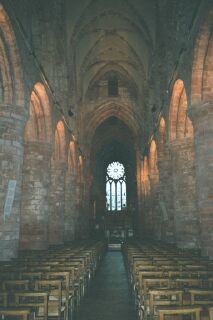
St. Magnus Cathedral
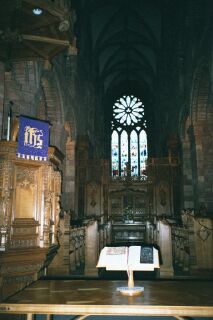
Inside St. Magnus Cathedral
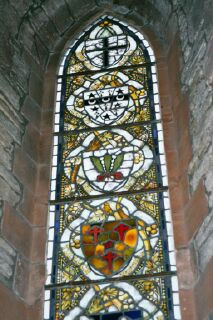
Stained Glass Window
More Orkneys
September 14, 2001
The Clan attended a memorial service at St. Magnus Cathedral, Kirkwall for the victims of the 9-11 terrorist attack on the World Trade Center in New York City, the Pentagon in Washington, DC and the hijacked plane that crashed near Shanksville, PA. Clan members Chairman Guy Irvin and Lillian Brown along with James Irvine participated in the service with Rev. Ronald Ferguson officiating. At 11 a.m. along with the rest of the world the Clan observed three minutes of silence at the Ring of Brodgar.
The Clan had a short tour of the Stones of Stenness that date from 3000 BC. We had a guided tour of Maes Howe considered "the finest chambered tomb in Western Europe" and dating from about 2700 BC. It is constructed from single stone slabs more than eighteen feet long and some four feet wide. The tomb was broken into by Viking crusaders returning from Jerusalem in the 12th Century who left a large collection of Viking runes carved on the walls. These runes and drawings such as the Maes Howe dragon (or lion) continue to serve as inspirations for the lovely jewellery and crafts produced today in Orkney.
Maes Howe is considered the most spectacular of Orkney's Neolithic chambered cairns. The interior of the tomb is illuminated at the time of the Winter Solstice when the setting sun shines through the entry passsage. Maes Howe along with the nearby Stones of Stenness, the Ring of Brodgar and Skara Brae form part of The Heart of Neolithic Orkney World Heritage Site and demonstrate "domestic, ritual and burial practices of a 5000-year old culture."
We drove to Stromness, took the 2-hour P&O Ferry trip to Scrabster and drove to Thurso where we spent the night at the St. Clair Hotel.
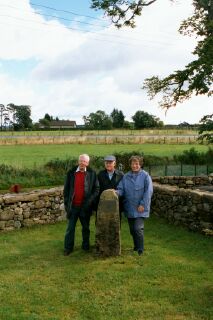
Irvine Caput
Banchory
September 15, 2001
This was a travel day heading south from Thurso to Latheron and along the coast to Inverness, then east to Elgin and southeast through Keith, Hunly, Howe of Alford and onto Banchory to the Tor-Na-Coille Hotel where we were greeted with tea or a wee dram and where we spent two nights in Irvine country.
The Clan attended a reception at Holly Leaf Cottage, home of David Irvine, 26th Baron of Drum and Chief of the Name and his wife the Baroness Caroline. This was the first opportunity for many Clan members to see their lovely new home and beautiful flowers, trees and garden. Then we returned to the Tor-Na-Coille for dinner.
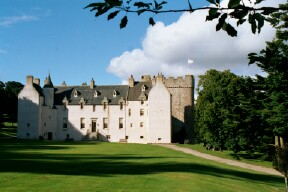
Drum Castle
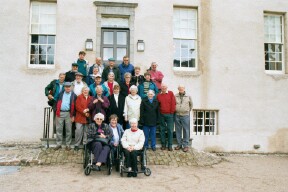
Clan Irwin at Drum Castle
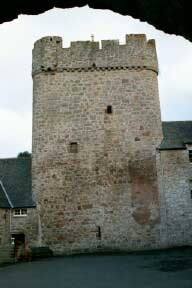
Drum Tower
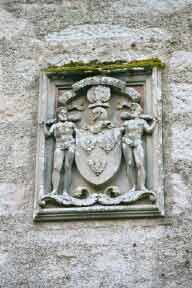
Coat of Arms
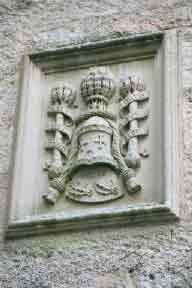
Coat of Arms
Drum Castle
September 16, 2001
This day was spent visiting "Irvine Country" with David and Caro as our guides. We went to the Bridge of Feugh hoping to see salmon leaping up the rocks and then along the south side of the Dee River to the Park Bridge over the Dee where David told us about the Mid-1300 to Early 1400 feud between the Keiths and the Irvines that culminated in several Keiths being drowned in the Dee at Keiths' Pot and their leader being killed by Irvine arrows on Keiths' Stone.
Then we went north to Auchronie to a hill to see the Drum Stone, another part of the Irvine-Keith History. We visited the Irvine Caput, a portion of Drum land that enables the Barony of Drum to continue in the Irvine family as it has since 1323. Lunch was enjoyed at the nearby Irvine Arms resturant.
The afternoon was spent with David and Caro guiding us to Drum Chapel, through Drum Castle up to the battlements of the tower and to see the walled garden. The lands of Drum were received by William de Irwin as a grant from Robert the Bruce in 1323. The Castle takes its name from the Gaelic Drum or Druim which means a ridge or knoll. The oldest part of the castle is the Keep, a 70 foot massive tower with immensely thick walls. The Keep is at least 300 years older than the rest of the castle, which includes an elegant 17th Century Jacobean mansion and additional late 18th Century alterations.
The Castle remained in the Irvine family until the 24th Laird Henry Quentin Irvine entered into an agreement with the National Trust for Scotland bequeathing Drum and its 411 acres to the Trust. Quentin was succeeded in 1975 as laird of Drum and Chief of the Name by his brother Lieutenant-Colonel Charles Francis Irvine. In 1992, Charles' son David Charles Irvine succeeded as 26th laird.
We returned to the Tor-Na-Coille Hotel for the formal Irvine of Drum dinner for American and Scottish Irvines and that featured cullin skink, haggis, and salmon.
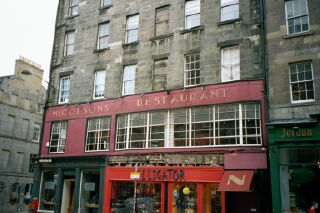
Nicholson Restaurant
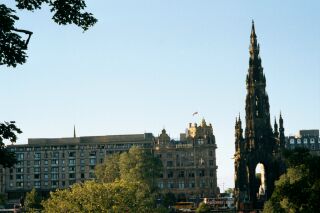
Sir Walter Scott Monument
Edinburgh
September 17, 2001
After breakfast at the hotel we took our leave of David and Caro Irvine and James Irvine. We headed south through Stonehaven and Dundee, across the Firth of Tay bridge and on to St. Andrews for lunch and sightseeing on the Old Course, St. Andrews University and the ruins of St. Andrews Cathedral. We continued south over the Firth of Forth bridge and on to Edinburgh to Jury's Hotel on Jeffries St., our home for two nights.
The Clan went in several directions for their time in Edinburgh. Our party walked to Jenner's Department Store on Princes Street, walked along the Royal Mile, had dinner at Deacon Brodie's Tavern (shades of Stevenson's Dr. Jekyl and Mr. Hyde,) proceeded to The Witchery restaurant and went on the "Murder and Mystery Tour" with Adam Lyal, deceased.
September 18, 2001
Free day for the Clan. Our party went back to Jenner's on Princes Street and then walked to the new Museum of Scotland on Chambers Street. This museum is a must-see and has a wonderful collection of artifacts, historical items and educational displays that are also fascinating. We also sought out Nicholson Restaurant on Nicholson Street where J. K. Rowling wrote the first "Harry Potter" book.
We toured Edinburgh Castle and saw the Stone of Scone and the Honors of Scotland. After dinner at Jury's Hotel we walked down the Royal Mile to Holyrood Palace and a view of the new Scottish parliament building, which is under construction.
September 19, 2001
It was time to pack all the suitcases, load up the bus and drive to the Glasgow airport. Farewell to nineteen of our twenty-three Clan members. A great thank-you to Guy and Betty Irvin for planning the trip and guiding our party through an unforgettable experience.
Continued in Part Two


